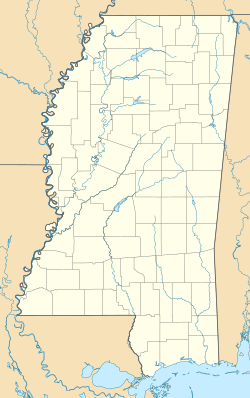Beth Israel Congregation (Jackson, Mississippi) facts for kids
Quick facts for kids Beth Israel Congregation |
|
|---|---|
|
Hebrew: בית ישראל
|
|
| Religion | |
| Affiliation | Reform Judaism |
| Ecclesiastical or organisational status | Synagogue |
| Leadership | Rabbi Joseph Rosen |
| Status | Active |
| Location | |
| Location | 5315 Old Canton Road, Jackson, Mississippi 39211 |
| Country | United States |
| Architecture | |
| Architect(s) | Joseph Willis (1875) |
| Architectural type | Synagogue |
| Architectural style | Gothic Revival (1875) |
| Date established | 1861 (as a congregation) |
| Completed |
|
Beth Israel Congregation (which means "House of Israel" in Hebrew) is a Jewish house of worship, called a synagogue, in Jackson, Mississippi. It is part of Reform Judaism, a modern branch of the Jewish faith.
The congregation started in 1860 with Jewish families who had moved from Germany. It is the only synagogue in the city of Jackson. The group built the very first synagogue in Mississippi in 1867.
Over the years, the congregation has had several different buildings. It also had a brave leader, Rabbi Perry Nussbaum, who was active in the Civil Rights Movement. Because of his work, the synagogue and his home were bombed by a hate group called the Ku Klux Klan in 1967.
Today, Beth Israel is a growing community with over 200 families. It is the largest Jewish congregation in Mississippi.
Contents
History of the Congregation
The First Synagogue in Mississippi
The Beth Israel Congregation was formed in 1860 by Jewish families from Germany. Their first goal was to create a Jewish cemetery. Soon after, they hired a cantor (a person who leads songs and prayers) to help teach the children of the 15 Jewish families in Jackson.
In 1867, the congregation built a wooden building for prayer services and a school. This was the first synagogue ever built in the state of Mississippi.
At first, the members had different ideas about how to practice their faith. Some were Orthodox, following older traditions. Others wanted to follow Reform Judaism, a more modern approach. This caused some disagreements, but the community was too small to split into two separate synagogues.
In 1870, the congregation hired its first rabbi (a Jewish spiritual leader), Reverend L. Winter. He introduced more modern practices, like services on Friday nights instead of Saturdays and sermons in English.
A New Building and a New Direction
In 1874, the synagogue burned down. The congregation quickly rebuilt it with brick and stone. The new building, finished in 1875, had a beautiful Gothic Revival style with pointed-arch windows.
In the same year, the congregation officially joined the Union of American Hebrew Congregations. This marked its formal move to Reform Judaism.
For many years, the congregation grew slowly. By the early 1900s, the neighborhood around the synagogue had become industrial. Many members had moved away from the area. In 1941, the congregation moved to a new building on East Woodrow Wilson Avenue.
The Civil Rights Era
Rabbi Perry Nussbaum's Leadership
In 1954, Dr. Perry Nussbaum became the rabbi of Beth Israel. He was a strong leader who was not afraid to speak his mind. He encouraged the congregation to embrace its Jewish identity and traditions more fully. He also strongly supported Zionism, the movement for a Jewish homeland in Israel.
Rabbi Nussbaum was a passionate supporter of the Civil Rights Movement. This was a time when many people, especially in the southern United States, were fighting for equal rights for African Americans. Nussbaum believed in justice and equality for all people.
He invited Black ministers to speak at the synagogue and worked with other religious leaders to promote understanding between different communities. He also helped the Freedom Riders, brave activists who traveled to the South to challenge unfair segregation laws.
The Bombings of 1967
Rabbi Nussbaum's work for civil rights made him a target for hate groups like the Ku Klux Klan (KKK). The KKK was a violent group that opposed equal rights for Black people and was also hostile toward Jews and other minorities.
In 1967, the congregation moved into a new, modern building on Old Canton Road. Just a few months later, on September 18, 1967, members of the KKK planted a bomb that badly damaged the new synagogue. The explosion tore a hole in the ceiling and blew out windows.
Two months later, the same group bombed Rabbi Nussbaum's home while he and his wife were asleep inside. Thankfully, they were not physically harmed.
Many people in the congregation were scared. Some blamed the rabbi's activism for the attacks. The synagogue's leaders even tried to stop him from holding interracial meetings there. Despite the danger and the pressure, Rabbi Nussbaum continued his work until he retired in 1973.
Beth Israel Today
After Rabbi Nussbaum retired, Beth Israel continued to be an important center for the Jewish community in Mississippi. The synagogue has had several rabbis who have continued its traditions of learning and community service.
In 2003, Valerie Cohen became the congregation's first female rabbi. This was a major milestone for Beth Israel.
The synagogue remains at its Old Canton Road location. In 2018, it was added as a stop on the Mississippi Freedom Trail. This honor recognizes the important role the synagogue and its members played in the fight for civil rights.
Today, Beth Israel is a thriving congregation that honors its long and important history while looking toward the future.


